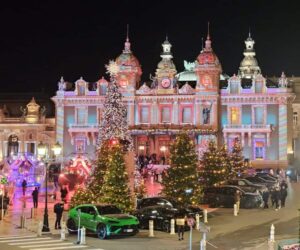How to Make the Most of a Minnesota Vikings Game at U.S. Bank Stadium
Andrew.Parks
Fri, 10/18/2024 – 09:37
U.S. Bank Stadium is the lively home of the Minnesota Vikings, the state’s beloved NFL team. Located in downtown Minneapolis — on the former Hubert H. Humphrey Metrodome site — the massive venue also hosts the Minnesota State High School League Football and Soccer Championships, top-of-the-line tours like Metallica, Taylor Swift and Beyoncé, and such major events as the Super Bowl, X Games and Monster Jam.
What To Read Next
Mystic Lake Casino’s Enduring Appeal
Read More
Pedal Your Way Through Central Minnesota
Read More
Things to Do in St. Louis Park
Read More
Get help from the experts to plan your trip
Want to know the best spots in Minnesota? How about tips on how to make the most of your time in a specific city? Our Minnesota experts can answer your questions, offer advice, or plan the perfect Minnesota trip for you. For free.
Sports
Article
Frances Fyten

The light rail line in downtown Minneapolis
HOW TO GET HERE
Many parking options are available within a 20 minute or less walk surrounding U.S. Bank Stadium, including the stadium parking ramp, which is connected via the skyway. Additional surface lots, parking ramps, and metered street parking are also available downtown. Many local restaurants in the area also offer complimentary shuttles if you choose to dine before or after an event.
Vikings fans gather outside U.S. Bank Stadium
/ Courtesy of the Minnesota Vikings
WHERE TO PARK
If you don’t want to drive and park downtown, U.S. Bank Stadium partners with ride share services and taxi companies to provide designated pick-up and drop-off locations outside the stadium.
Fans are also encouraged to use alternative modes of transportation, such as walking the Minneapolis Skyway, biking, or taking public transportation, such as the light rail or bus.

Fans cheer at U.S. Bank Stadium
/ Courtesy of the Minnesota Vikings
WHAT TO EXPECT
A Vikings outing is especially colorful when their biggest rivals — the Green Bay Packers — are in town. Look out for those cheese heads!
Spending a Sunday afternoon at U.S. Bank Stadium is a must for any football fan regardless of who the purple and gold are playing, however. Its majestic glass building mimics an outdoor game, but keeps fans toasty during the winter. And before the game, a special guest ignites the crowd by sounding the Gjallarhorn — a massive mythological Viking horn — and leads the fight song Edina composer James “Red” McLeod created in the early ’60s.
Fans and players clap their hands in unison while chanting “skol!” alongside the steady beat of a drum line. Be sure to keep an eye out for antics from the team’s mascot (Viktor the Viking) on the sidelines, too.

Credit: U.S. Bank Stadium
WHAT TO EAT & DRINK
Fans can find local favorites throughout U.S. Bank Stadium, including sliders from Union Hmong Kitchen (Section 101), street tacos from Rusty Taco (Sections 105, 114 and 311), crispy and gooey cheese curds from Curds & Cakes (Sections 114 and 310), and burgers galore from Birch’s Brewhouse on the Lake (section 214).
Looking for a classic game time snack? Von Hanson’s Meats and Top Dog have you covered with hot dogs and brats. Plus there are plenty of options for a quick drink, slice of pizza, chicken strips, popcorn or sweet treats near every section.

Argentinian-style pizza at Boludo in Minneapolis
/ Vic Campbell, Courtesy of Meet Minneapolis
OTHER RESTAURANTS AND BARS NEAR THE STADIUM
U.S. Bank Stadium is in the heart of downtown Minneapolis, so dining options are plentiful and varied. Boludo is steps from the stadium and provides a taste of Buenos Aires through specialty pizzas and homemade empanadas. Head to Pog Mohone’s Pub & Grill and Crooked Pint Ale House for a laid-back atmosphere and outstanding burgers and beers, or walk a few blocks to Day Block Brewing or Town Hall Brewing for a pint and quick bite.
Chloe by Vincent serves up casual French fare, including a large selection of small plates and French classics, such as French onion soup and beef bourguignon. Zen Box Izakaya, a restaurant specializing in ramen and Japanese comfort food, is a local favorite as well.
If none of these options sound like they’d hit the spot, just remember there are many great dining options spread throughout the city, including some that can be found right on the other side of the Mississippi River.

Four Seasons Hotel Minneapolis
WHERE TO STAY
Minneapolis is home to dozens of hotels, many of which offer complimentary shuttles to and from events. Several are within walking distance of the stadium, including chains like Canopy by Hilton, Hilton Garden Inn, Courtyard by Marriott, AC Hotel, Residence Inn, and Hyatt Regency.
Or you could always splurge for a luxurious stay at the city’s first five-star property, Four Seasons Hotel Minneapolis, which features a food and drink program overseen by critically acclaimed chef Gavin Kaysen (Spoon & Stable, Demi).

Minnesota Vikings Museum
/ Credit: Visit Saint Paul
ADDITIONAL INFO
The Vikings’ regular season is September through January. Find their current schedule and ticket information on the team’s official website.
For information regarding accessibility options at the stadium, please visit U.S. Bank’s resource page.
To learn more about the team’s long history and its devoted fans, visit the Vikings Museum at their training facility in Eagan. It houses a 360-degree video theater, multiple interactive exhibits, and hundreds of historical artifacts so fans can learn the stories and insider details of the franchise.
Find out more about sports in Minnesota.

Minnesota Vikings game at U.S. Bank Stadium








